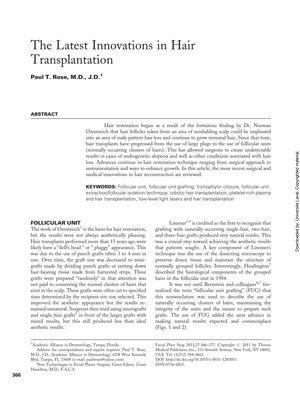The Latest Innovations in Hair Transplantation
July 2011
in “Facial Plastic Surgery”

TLDR New hair transplant methods offer more natural results and better graft survival, with ongoing research to increase donor hair options.
The document from July 26, 2011, reviews advancements in hair transplantation, highlighting the shift from large punch grafts to more natural-looking follicular unit grafting (FUG). It introduces techniques like trichophytic closure for less visible scarring and tissue spreaders to reduce follicle trauma. The article also discusses follicular unit extraction (FUE) or follicular isolation technique (FIT), which avoids linear scarring but may cause a moth-eaten look and has higher transection rates, especially in curly hair. FUE/FIT is useful for limited donor hair, small graft numbers, and scar management. Body hair is considered a last resort for donor hair. The document notes the importance of achieving 50% density in the recipient area and details eyebrow and eyelash transplantation techniques. It mentions motorized devices for efficient graft harvesting, with transection rates around 10%, and the use of platelet-rich plasma (PRP) and low-level light lasers for hair growth, although PRP's effectiveness is not fully established. Storage solutions for grafts are being optimized, and medical therapies include finasteride, minoxidil, and potentially bimatoprost. The document concludes that while FUG is refined, ongoing innovations aim to improve implantation and survivability, with future developments possibly providing an unlimited donor hair supply. The author has a conflict of interest as a consultant and shareholder in Restoration Robotics.
View this study on thieme-connect.de →
Related

research Hair loss (alopecia or baldness)
Baldness is often hereditary and linked to male hormones, becoming noticeable when half the hair is lost.

research Treatments of hereditary hair loss (alopecia)
Some treatments like minoxidil, finasteride, and surgery can help with hereditary hair loss.

research Body to scalp: Evolving trends in body hair transplantation
Body hair transplants can treat baldness but differ from scalp hair and need more research on long-term results and side effects.

research The Latest Innovations in Hair Transplantation
New hair transplant methods offer more natural results and better graft survival, with ongoing research to increase donor hair options.